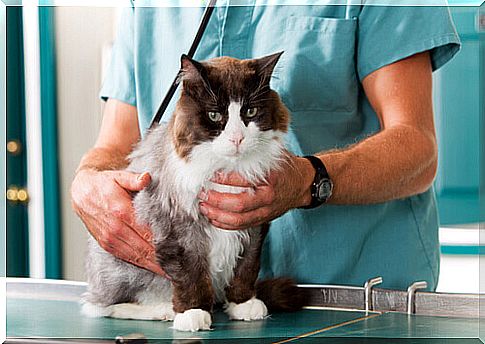Toxoplasmosis And Cats

It is a disease caused by the parasite Toxoplasma godii. As it is an asymptomatic pathology, it is not easily detected. Although it can be transmitted from animals to humans, the most common routes of contagion for humans are different. There are many myths about toxoplasmosis in cats and the risk it poses to people. Therefore, and in order to demystify some issues, we will pass on some information.
What is Toxoplasmosis?
Toxoplasmosis is an infectious disease caused by one of the most common parasites in the world : Toxoplasma gondii .
This organism can infect all mammals. And the only ones that eliminate it through feces, that is, that are transmitters or final guests of the parasite, are the cats. The rest keep it in their body and are only infected if they eat raw or semi-raw meat.

Why are cats transmitters? Because they fulfill certain conditions in your body so that the biological cycle of toxoplasmosis develops in your intestinal phase.
Risk of contagion to human beings
Despite popular belief, having a cat as a pet does not increase the risk. In fact, it is highly unlikely that the feline is responsible for spreading the disease to a person, even if the person is pregnant. Because? Because a series of specific circumstances that rarely occur together must be presented, such as:
- That the animal is infected for the first time, since, once the disease is contracted, it acquires immunity.
- When cat feces remain in place for more than 24 hours and less than 5 days.
- The person has contact with the feces with their bare hands and takes them to the mouth or handles food.
Even if the pet is infected, it is difficult for the disease to infect people who live with it.
In any case, there are more common transmission situations for humans. This is the case of eating raw or undercooked meat, contaminated fruits or vegetables, or water without proper sanitary treatment.
animal contagion
To catch the disease, the cat must come into contact with the parasite by eating contaminated meat. For example, eating a sick rodent, bird or other animal, or previously infected raw meat.
If it is a pet, it is more likely that it will be fed at home with prepared food, feed or canned food. And it will hardly come into contact with infectious outbreaks.
However, if he contracts the virus, toxoplasmosis in the cat takes about 15 days to reproduce. It lodges in the animal’s intestine, forming some eggs called oocysts, which are eliminated through the feces.
Symptoms of toxoplasmosis in cats
As it is an asymptomatic disease, the animal does not show clear signs of suffering. However, there are certain warning signs that should be considered, such as:
- Diarrhea
- Lack of appetite
- Fever
- Apathy
- difficulty breathing
- low defenses
If you notice any of these symptoms, you should go to a veterinarian. He will take a blood sample and consider the most appropriate diagnosis and treatment.
How to prevent illness in your pet
By taking very simple precautions, it is possible to prevent the cat from contracting the parasite:
- First, take care of his diet and the places where he eats food. Wherever packaged food is involved, such as kibble or home-cooked meals, there will be no risk.
- Avoid giving him raw meat. Also, as far as possible, control if it comes into contact with external animals.
- Check if he has up to date vaccines and carry out periodic veterinary checks to ensure that his health is in perfect condition.

Toxoplasmosis treatment
If detected the disease, the professional will indicate the administration of antibiotics for at least two weeks. Of course, this will depend on the development and symptoms. Afterwards, you will control the evolution and recovery of your pussy.
home security
In summary, toxoplasmosis in cats can occur without symptoms and without sequelae. The important thing is to take care of your pet’s food and hygiene and go to the vet in case of any symptoms.
It is usually reassuring to know that a cat in the home does not pose any risk of contagion for its members. Always take the minimum precautions for cleanliness, and pay due attention to their behavior.









